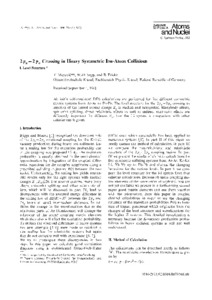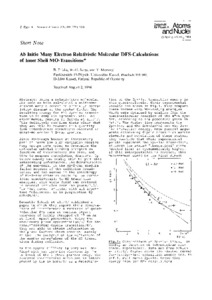Suche
Anzeige der Dokumente 1-10 von 44
Aufsatz
 Relativistic Dirac-Fock-Slater program to calculate potential-energy curves for diatomic molecules
Relativistic Dirac-Fock-Slater program to calculate potential-energy curves for diatomic molecules
(1986)
A LCAO-MO (linear combination of atomic orbitals - molecular orbitals) relativistic Dirac-Fock-Slater program is presented, which allows one to calculate accurate total energies for diatomic molecules.
Numerical atomic Dirac-Fock-Slater wave functions are used as basis functions. All integrations as well as the solution of the Poisson equation are done fully numerical, with a relative accuracy of 10{^-5} - 10{^-6}. The details of the method as well as first results are presented here.
Aufsatz
 Relativistic calculations of atomic structure
Relativistic calculations of atomic structure
(1984)
A review of relativistic atomic structure calculations is given with a emphasis on the Multiconfigurational-Dirac-Fock method. Its problems and deficiencies are discussed together with the contributions which go
beyond the Dirac-Fock procedure.
Aufsatz
 Relativistic many-electron SCF correlation diagram for superheavy quasimolecules: Pb - Pb
Relativistic many-electron SCF correlation diagram for superheavy quasimolecules: Pb - Pb
(1981)
We present the first relativistic many-electron SCF correlation diagram for a superheavy quasimolecule: Pb - Pb. The discussion shows a large number of quantitative as well as qualitative differences as compared with the known one-electron correlation diagram.
Aufsatz
 An attempt on the calculation of relativistic potential energy curves: noble gas difluorides
An attempt on the calculation of relativistic potential energy curves: noble gas difluorides
(1980)
Total energy SCF calculations were performed for noble gas difluorides in a relativistic
procedure and compared with analogous non-relativistic calculations. The discrete
variational method with numerical basis functions was used. Rather smooth potential
energy curves could be obtained. The theoretical Kr - F and Xe - F bond distances were calculated to be 3.5 a.u. and 3.6 a.u. which should be compared with the experimental values of 3.54 a.u. and 3.7 a.u. Although the dissociation energies are off by a factor of ...
Aufsatz
 Comparison between experiment and theory in heavy electronic systems
Comparison between experiment and theory in heavy electronic systems
(Gräff, G. (Hrsg.), 1981)
Aufsatz
 On the total energy of two-electron atoms
On the total energy of two-electron atoms
(1985)
Using the Multi-Configuration Dirac-Fock (MCDF) method we calculate with 9 configuration state functions the correlation energy as well as the total energy of the lowest J = 0 ground state of all two-electron systems from H- to Thorium (Z = 90). A comparison with experimental data, which are available only in the low Z region, shows a very good agreement.
Aufsatz
 {2p_\pi}-{2p_\sigma} crossing in heavy symmetric ion-atom collisions: I. Level structure
{2p_\pi}-{2p_\sigma} crossing in heavy symmetric ion-atom collisions: I. Level structure
(1982)
Ab initio self-consistent DFS calculations are performed for five different symmetric
atomic systems from Ar-Ar to Pb-Pb. The level structure for the {2p_\pi}-{2p_\sigma} crossing as function of the united atomic charge Z_u is studied and interpreted. Manybody effects, spin-orbit splitting, direct relativistic effects as well as indirect relativistic effects are differently important for different Z_u. For the I-I system a comparison with other calculations is given.
Aufsatz
 Many-electron relativistic calculation and interpretation of atomic processes in time dependent heavy-ion scattering
Many-electron relativistic calculation and interpretation of atomic processes in time dependent heavy-ion scattering
(1989)
The time dependence of a heavy-ion-atom collision system is solved via a set of coupled channel equations using energy eigenvalues and matrix elements from a self-consistent field relativistic molecular many-electron Dirac-Fock-Slater calculation. Within this independent particle model we give a full many-particle interpretation by performing a small number of single-particle calculations.
First results for the P(b) curves for the Ne K-hole excitation for the systems F{^8+} - Ne and F{^6+} - Ne as examples are discussed.
Aufsatz
 State-dependent volume isotope shifts of low-lying states of group-IIa and -IIb elements
State-dependent volume isotope shifts of low-lying states of group-IIa and -IIb elements
(1985)
Results of relativistic multiconfiguration Dirac-Fock calculations with an extended nucleus are used to analyze the volume isotope shifts of the resonance transitions in the group-IIa and -IIb elements
as well as in Yb. This is done together with a review of the isotope shift theory, including a critical evaluation and comparison of the semiempirical calculation of volume isotope shifts commonly
used today. Electronic factors F_i, proportional to differences of electronic densities over the nuclear volume, are ...










